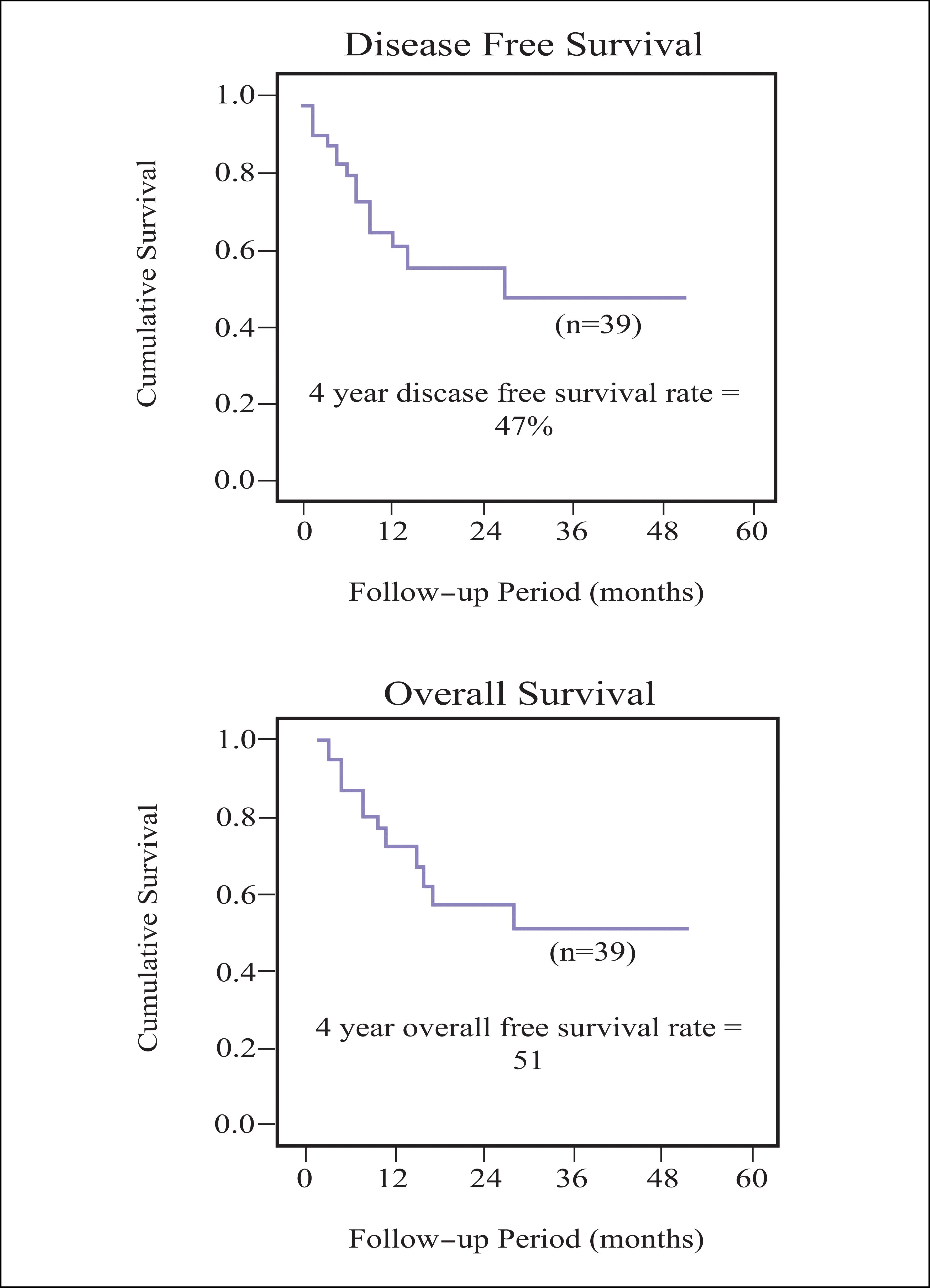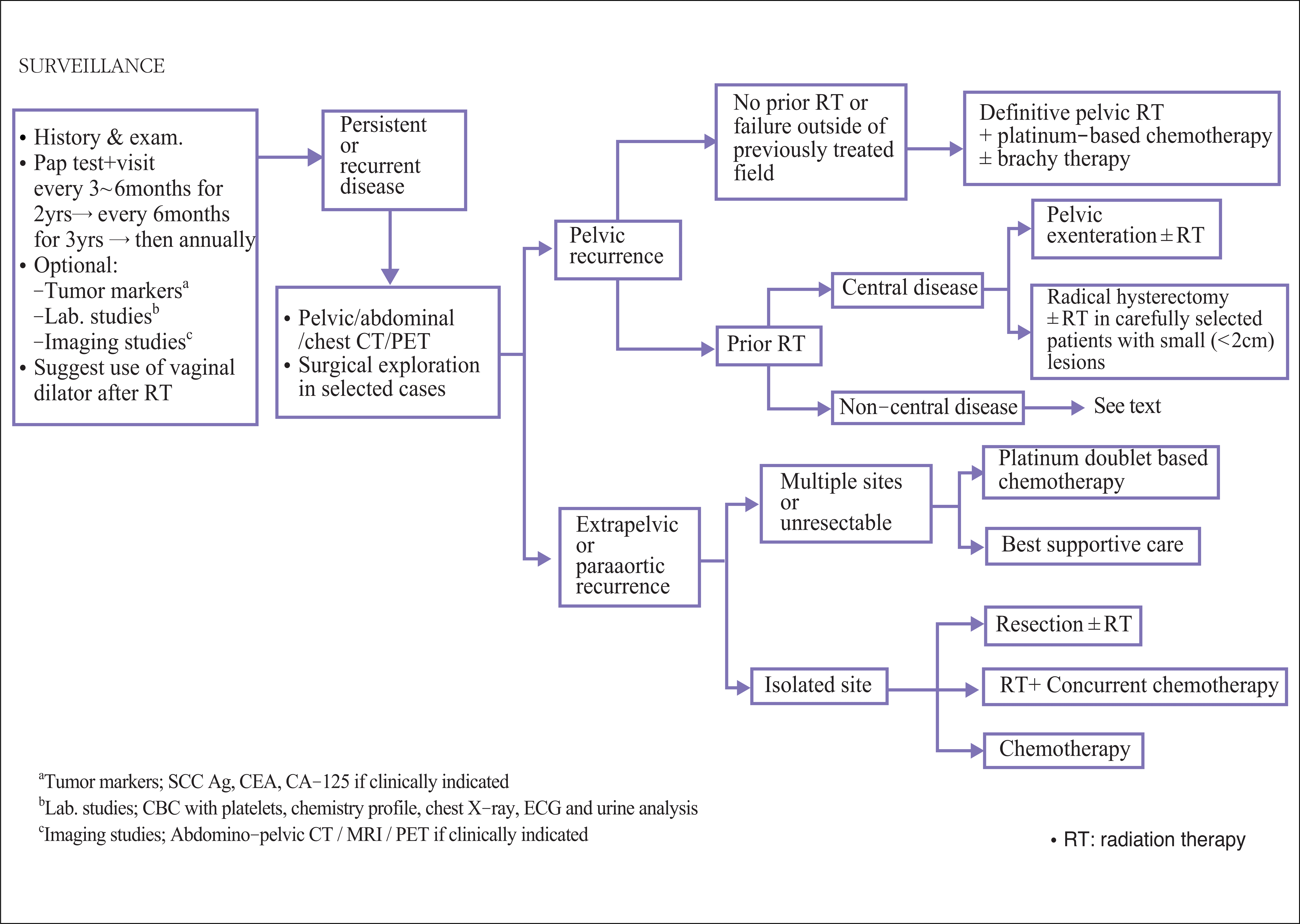Abstract
Despite recent advances in the early detection method and treatment modalities (surgery and/or radiation and/or chemotherapy), cervical cancer is still an important malignant disease in women. Almost half a million new cases occur every year in the world. The management of recurrent cervical cancers depends on primary treatment, the extent of disease, and performance status. Patients who received primary surgical treatment without radiotherapy (RT) may undergo curative RT. However, most recurrences occur in patients with advanced-stage disease already treated by primary RT. For patients who failed primary RT or surgery plus adjuvant RT and had central relapse without pelvic sidewall recurrence, pelvic exenteration may be necessary. For patients who had pelvic sidewall recurrences, pelvic exenteration is usually not an option with curative intent. In such situation, combined operative and radiotherapeutic treatment (CORT), and laterally extended endopelvic resection (LEER), intraoperative radiotherapy (IORT) have been executed with some success. Simple or radical hysterectomy can be considered for patients who had small uterine and/or vaginal recurrences, but the high frequency of associated morbidities such as urinary and bowel tract injury or fistula is the problem. Patients with multiple or distant metastases are destined to receive cisplatin-based palliative chemotherapy. Recently there was a GOG 179 study that had firstly shown a statistically significant improvement on the overall response rate, median progression-free survival, and median survival. Until now, however, the role of chemotherapy has been very limited.
References
1. National Cancer information. Cancer, korea. http://www.cancer.go.kr/.
2. Parkin DM, Bray F, Ferlay J, Pisani P. Estimating the world cancer burden: Globocan 2000. Int J Cancer. 2001; 94:153–156.

3. Landoni F, Maneo A, Colombo A, Placa F, Milani R, Perego P, Favini G, Ferri L, Mangioni C. Randomised study of radical surgery versus radiotherapy for stage Ib?IIa cervical cancer. Lancet. 1997; 350:535–540.

4. Maneo A, Landoni F, Cormio G, Colombo A, Mangioni C. Radical hysterectomy for recurrent or persistent cervical cancer following radiation therapy. Int J Gynecol Cancer. 1999; 9:295–301.

5. Coleman RL, Keeney ED, Freedman RS, Burke TW, Eifel PJ, Rutledge FN. Radical hysterectomy for recurrent carcinoma of the uterine cervix after radiotherapy. Gynecol Oncol. 1994; 55:29–35.

6. Shingleton HM, Soong SJ, Gelder MS, Hatch KD, Baker VV, Austin JM Jr. Clinical and histopathologic factors predicting recurrence and survival after pelvic exenteration for cancer of the cervix. Obstet Gynecol. 1989; 73:1027–1034.

7. Estape R, Angioli R. Surgical management of advanced and recurrent cervical cancer. Semin Surg Oncol. 1999; 16:236–241.
8. Matthews CM, Morris M, Burke TW, Gershenson DM, Wharton JT, Rutledge FN. Pelvic exenteration in the elderly patient. Obstet Gynecol. 1992; 79:773–777.

9. Goldberg JM, Piver MS, Hempling RE, Aiduk C, Blumenson L, Recio FO. Improvements in pelvic exenteration: factors responsible for reducing morbidity and mortality. Ann Surg Oncol. 1998; 5:399–406.

10. Morley GW, Hopkins MP, Lindenauer SM, Roberts JA. Pelvic exenteration, University of Michigan: 100 patients at 5 years. Obstet Gynecol. 1989; 74:934–943.

11. Rutledge FN, Smith JP, Wharton JT, O'Quinn AG. Pelvic exenteration: analysis of 296 patients. Am J Obstet Gynecol. 1977; 129:881–892.

12. Jain AK, DeFranzo AJ, Marks MW, Loggie BW, Lentz S. Reconstruction of pelvic exenterative wounds with transpelvic rectus abdominis flaps: a case series. Ann Plast Surg. 1997; 38:115–122. ; discussion 122–123.
13. Soper JT, Berchuck A, Creasman WT, Clarke?Pearson DL. Pelvic exenteration: factors associated with major surgical morbidity. Gynecol Oncol. 1989; 35:93–98.

14. Copeland LJ, Hancock KC, Gershenson DM, Stringer CA, Atkinson EN, Edwards CL. Gracilis myocutaneous vaginal reconstruction concurrent with total pelvic exenteration. Am J Obstet Gynecol. 1989; 160:1095–1101.

15. Ratliff CR, Gershenson DM, Morris M, Burke TW, Levenback C, Schover LR, Mitchell MF, Atkinson EN, Wharton JT. Sexual adjustment of patients undergoing gracilis myocutaneous flap vaginal reconstruction in conjunction with pelvic exenteration. Cancer. 1996; 78:2229–2235.
16. Höckel M, Knapstein PG, Kutzner J. A novel combined operative and radiotherapeutic treatment approach for recurrent gynecologic malignant lesions infiltrating the pelvic wall. Surg Gynecol Obstet. 1991; 173:297–302.
17. Höckel M. Laterally extended endopelvic resection. Novel surgical treatment of locally recurrent cervical carcinoma involving the pelvic side wall. Gynecol Oncol. 2003; 91:369–377.
18. Höckel M. The transversus and rectus abdominis musculo-peritoneal (TRAMP) composite flap for vulvovaginal recons truction. Plast Reconstr Surg. 1996; 97:455–459.
20. Seki M, Nakagawa K, Tsuchiya S, Matsubara T, Kinoshita I, Weng SY, Tsuchiya E. Surgical treatment of pulmonary metastases from uterine cervical cancer. Operation method by lung tumor size. J Thorac Cardiovasc Surg. 1992; 104:876–881.
21. Anraku M, Yokoi K, Nakagawa K, Fujisawa T, Nakajima J, Akiyama H, Nishimura Y, Kobayashi K. Metastatic Lung Tumor Study Group of Japan. Pulmonary metastases from uterine malignancies: results of surgical resection in 133 patients. J Thorac Cardio vasc Surg 2004. 127:. 1107–1142.
22. Ijaz T, Eifel PJ, Burke T, Oswald MJ. Radiation therapy of pelvic recurrence after radical hysterectomy for cervical carcinoma. Gynecol Oncol. 1998; 70:241–246.

23. Averette HE, Lichtinger M, Sevin BU, Girtanner RE. Pelvic exenteration: a 15?year experience in a general metropolitan hospital. Am J Obstet Gynecol. 1984; 150:179–184.

24. Mahe MA, Gerard JP, Dubois JB, Roussel A, Bussieres E, Delannes M, Guillemin F, Schmitt T, Dargent D, Guillard Y, Martel P, Richaud P, Cuilliere JC, De Ranieri J, Malissard L. Intraoperative radiation therapy in recurrent carcinoma of the uterine cervix: report of the French intraoperative group on 70 patients. Int J Radiat Oncol Biol Phys. 1996; 34:21–26.
25. Martinez?Monge R, Jurado M, Aristu JJ, Moreno M, Cambeiro M, Perez?Ochoa A, Lopez?Garcia G, Alcazar JL. Intraoperative electron beam radiotherapy during radical surgery for locally advanced and recurrent cervical cancer. Gynecol Oncol. 2001; 82:538–543.
26. Garton GR, Gunderson LL, Webb MJ, Wilson TO, Cha SS, Podratz KC. Intraoperative radiation therapy in gynecologic cancer: update of the experience at a single institution. Int J Radiat Oncol Biol Phys. 1997; 37:839–843.

27. The Korea Society of Gynecologc Oncology and Colposcopy. Practice guideline for gynecologic cancer version. 1:17. 2006.
28. Park JY, Choi HJ, Jeong SY, Chung JS, Park JK, Park SY, The role of pelive exenteration and reconstruction for treatment of advanced or recurrent gynecologic malignancies; analysis of risk factors predicting recurrence and survival. J Sung Oncal. 2007; 20:e?publication.
Figure 1.
Reconstuctive surgery after pelvic exenteration surgery. A) Formation of ileal conduit. B) After total pelvic exenteration. C∼E) Formation of neovagina using vertical rectus abdominus myocutaneous flap. F) Follow-up of neovagina one year later.

Figure 2.
Combined operative and radiotherapeutic treatment (CORT) was performed in case of clear but close resection margins to structures or residual disease after laterally extended endopelvic resection (LEER). A) Complete array of transabdominal guide tubes for postoperative brachytherapy fixed to the lesion by the brigde implant and additional sutures. B) Vertical rectus abdominus myocutaneous flap used as pelvic wall plasty for CORT. C) Completion of CORT procedure (open arrow; ileal conduit, closed arrow; colostomy). D) Postoperative computedtomogram. The lowermostthree figures showed a CORT set including fixation bridges and guide tubes.

Figure 4.
The median disease free survival was 27 months, and the disease free survival probability at 51 months was 47.1%. The median overall survival time did not reach, and the overall survival probability at 51 months was 51.1%.

Figure 5.
Overall survival by the resection margin status (left)(negative margin, n=37 vs. positive margin, n=7) and lymph node metastasis (right)(negative, n=40, vs. positive, n=4) after adjustment for tumor size, bladder wall invasion, status of resection margin, and lymph node metastasis (Cox regression model, P = 0.017 and 0.012, respectively).

Table 1.
Chemotherapy regimens for recurrent or metastatic cervical cancer
| First-line therapy | Possible first-line combination therapy∗ | Second-line therapy |
|---|---|---|
| Cisplatin | Cisplatin/paclitaxel | Docetaxel |
| Carboplatin | Cisplatin/topotecan | Ifosfamide |
| Paclitaxel | Cisplatin/gemcitabine | Vinorelbine |
| Topotecan | Carboplatin/paclitaxel | Irinotecan |
| Epirubicin | ||
| Mitomycin | ||
| 5-FU |
Table 2.
Surgical procedures
Table 3.
Bowel and Urinary Complications




 PDF
PDF ePub
ePub Citation
Citation Print
Print



 XML Download
XML Download